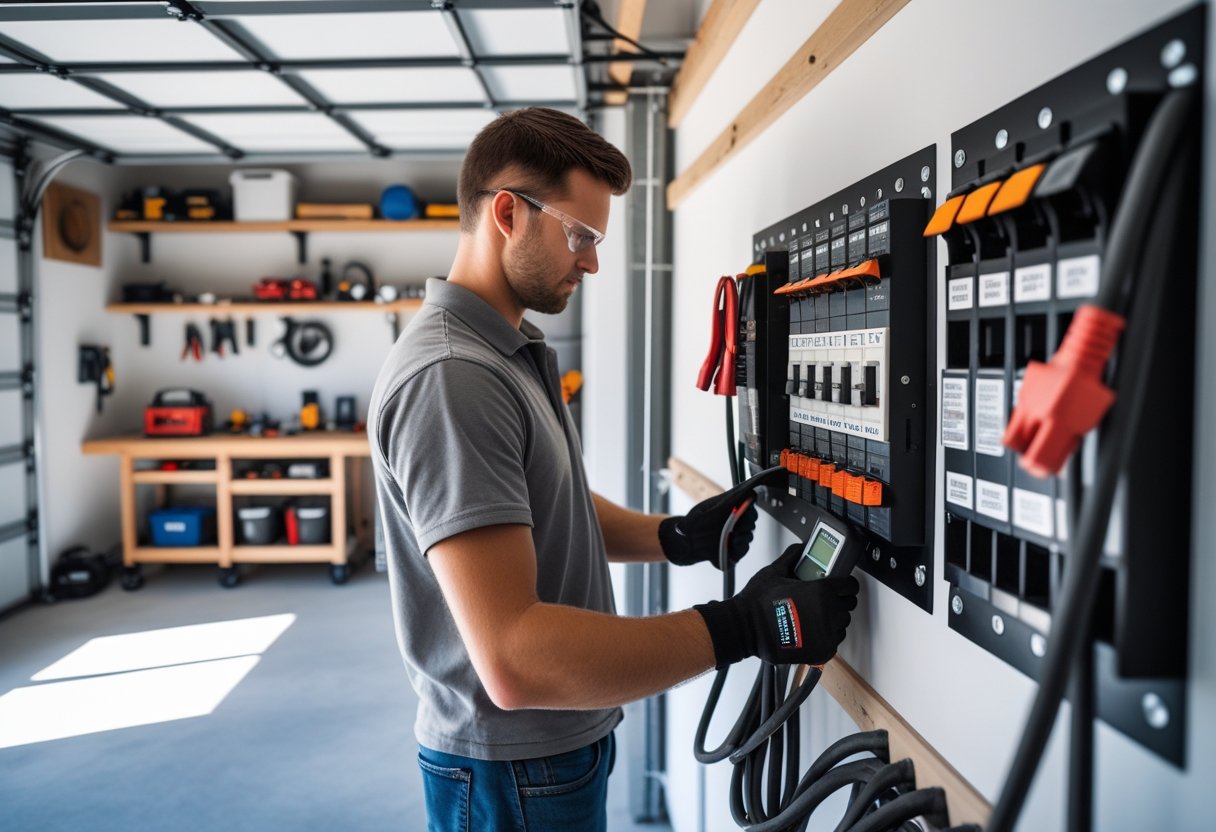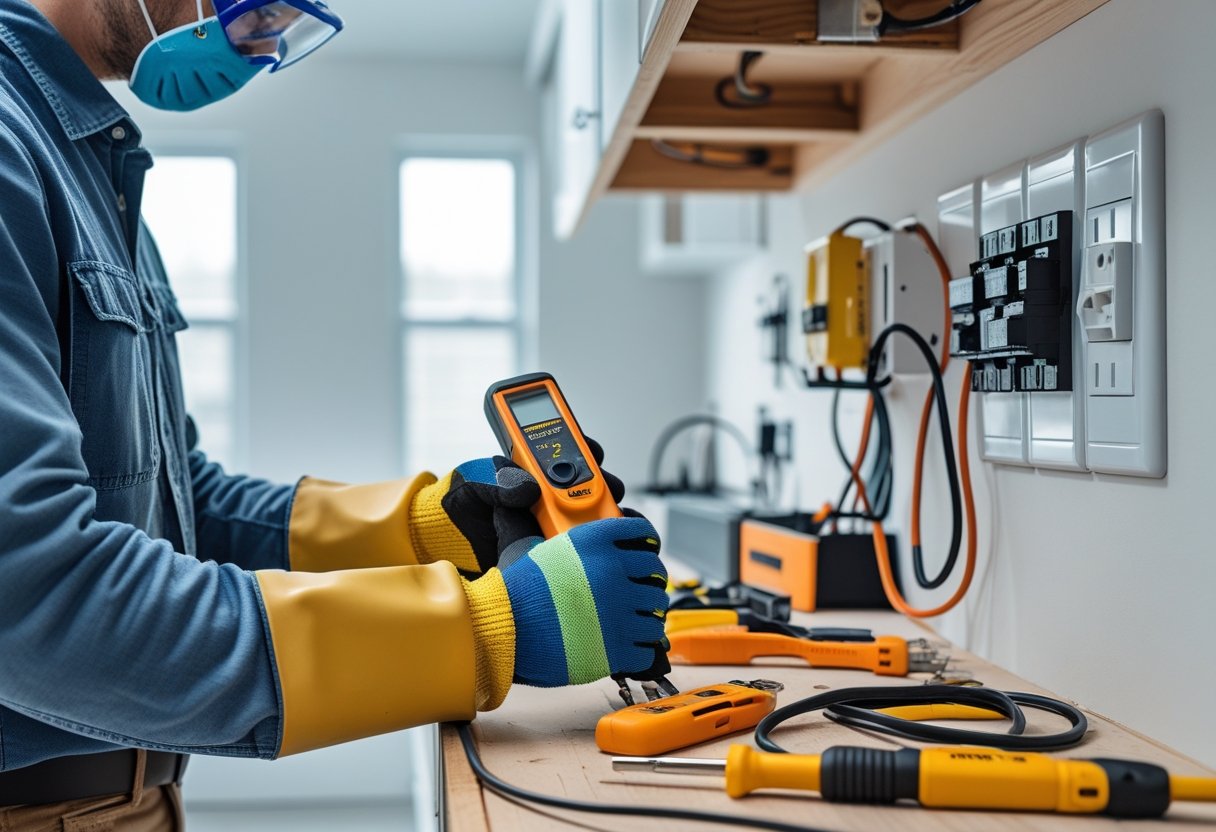If your circuit breaker keeps tripping or you notice flickering lights, these could be signs of an overloaded circuit. An overloaded circuit happens when too many devices pull power from the same wiring, causing the breaker to shut off to prevent damage or fire.
Knowing how to spot this can help you keep your home safe and avoid bigger electrical problems. You might also hear buzzing sounds from outlets or feel warmth on wall plates, which can point to too much current flowing through one circuit.
Learning to identify these signs early helps you protect your appliances and prevent dangerous situations.
Understanding Electrical Circuits
Electrical circuits carry electricity to power your devices safely. Knowing how circuits work helps you spot when too much is being used at once.
You will learn what a circuit is, how breakers keep things safe, and the types of electrical loads you might have.
What Is an Electrical Circuit
An electrical circuit is a path where electricity flows to power your devices. It usually starts at your electrical panel and moves through wires to outlets, lights, or appliances.
Electricity needs a complete loop to work properly. If a circuit is broken or open, devices won’t get power.
Circuits can have one or many outlets. Circuits have limits and can only handle a certain amount of electricity safely before they overload.
Overloaded circuits can cause safety problems like breakers tripping.
Role of Circuit Breakers
Circuit breakers are safety devices in your panel. They stop electricity flow if too much power runs through a circuit.
When a breaker "trips," it cuts the power to prevent heat buildup or fires. This usually happens because too many devices run at once or there is a problem like a short circuit.
You can reset the breaker by switching it off and on again. If it trips often, there might be a bigger problem like an overloaded circuit or faulty wiring.
Breakers protect your home and appliances by stopping electrical damage before it gets worse.
Types of Loads in a Circuit
Loads are the devices or appliances that use electricity in a circuit. There are two main types: resistive loads and inductive loads.
Resistive loads include items like heaters or lights. They use electricity in a steady way.
Inductive loads include motors in fans, refrigerators, or air conditioners. They draw more power when they start up.
Knowing what kind of loads you have helps you figure out if your circuit is working safely. Too many big inductive or resistive loads at once can make breakers trip or wires overheat.
Common Signs of an Overloaded Circuit
When your electrical system uses too much power, you might notice some clear warnings. These signs help you spot an overloaded circuit early.
Frequent Tripping of Breakers
If your circuit breaker trips often, the circuit is drawing more current than it can handle. This happens when you plug in too many devices or power-hungry appliances on the same circuit.
Each time the breaker trips, it shuts off the power to protect your wiring from overheating. If this keeps happening, don’t just reset the breaker repeatedly.
Identify what’s causing the overload and reduce the load or move some devices to a different circuit. Frequent breaker trips can also mean there’s a fault in the wiring.
Dimming or Flickering Lights
When lights dim or flicker while you use other devices, the circuit might be overloaded. This happens because the electrical current is not steady.
When a heavy appliance starts up or runs, it pulls a lot of power, causing a temporary drop in voltage. This makes your lights flicker or get dimmer briefly.
If this happens regularly, especially in certain rooms or with specific devices, the circuit is struggling to provide enough power. Reducing the number of devices or redistributing them can help.
Warm or Discolored Wall Plates
If your light switches or wall plates feel warm or look discolored, there could be too much electrical load or a loose connection. Heat builds up when electricity passes through wiring or connections that aren’t working well or are overloaded.
This is a warning sign because too much heat can damage your home’s wiring and increase fire risk. Check for bad switches or outlets that need replacing.
Avoid overloading the circuit by plugging in fewer devices or spreading them across other circuits.
How to Check for Overloaded Circuits
You’ll need to know the circuit’s limit, figure out how much power your devices use, and test outlets and appliances. This helps you find if a circuit is carrying too much electrical load.
Identifying the Circuit’s Capacity
Start by finding your circuit breaker panel. Each breaker usually says its capacity in amps, like 15 or 20 amps.
This number tells you the max current the circuit can safely handle. Look for labels on the panel or the breaker itself.
If labels are missing or unclear, check your home’s electrical plan or ask an electrician. Knowing this limit helps you avoid overloading the circuit.
Circuits with lower amps are usually for lighting, while higher-amp circuits power big appliances.
Calculating the Load on a Circuit
Add up the wattage of all devices plugged into the circuit. Common high-power devices include heaters, microwaves, and refrigerators.
Use this formula to find amps:
Amps = Watts ÷ Volts
Assume your home voltage is 120 volts.
For example, a 1500-watt heater uses about 12.5 amps (1500 ÷ 120 = 12.5). Make sure the total amps don’t come close to or exceed the breaker's rating.
Stay under 80% of the breaker’s capacity to prevent trips.
Testing Outlets and Appliances
Check if outlets feel warm or show signs of damage. This can mean too much current.
Unplug devices one by one to see if flickering or trips stop. Use a voltmeter to test outlets.
Measure voltage at the outlet or breaker terminals. Stable voltage means the circuit is likely okay.
Faulty appliances can cause breaker trips even if the circuit isn’t overloaded. Test by plugging each device into a different circuit.
If you find frequent trips or dim lights when using many devices, the circuit may be overloaded or faulty wiring might be the issue.
Dangers of Ignoring Overloaded Circuits
Ignoring overloaded circuits can cause serious problems in your home. These issues include potential fires, damage to your electrical system, and risks to the safety of everyone living there.
Fire Hazards
Overloaded circuits produce heat because too much electrical current flows through wires that aren’t designed to handle it. This excess heat can cause the wiring to melt or the insulation to burn.
If the heat builds up, it may start a fire inside your walls or at outlets. Flickering lights, outlets that feel warm to the touch, or breakers that trip often are signs of this problem.
A fire caused by electrical issues usually starts slowly but can spread quickly.
Electrical Damage
When a circuit is overloaded, your breakers will trip frequently to prevent damage. If this happens often, it can wear out the breakers or other parts of your electrical system.
Wires that are constantly overheated may become brittle or cracked. This damage can cause shorts or faults that are costly to fix.
Faulty electrical components may also cause appliances to malfunction or stop working.
Safety Risks to Residents
Overloaded circuits create real safety risks for anyone in your home. The heat and sparks caused by faulty wiring can cause shocks or burns.
If a circuit breaker fails to trip because it is worn out, the risk gets even higher. You could get an electric shock from damaged outlets or appliances.
Young children, elderly people, or pets are especially vulnerable to electrical accidents. Keeping circuits in good shape helps everyone stay safe.
Preventing Circuit Overloads
To keep your home’s electrical system safe and working well, manage how your devices use power. Spread out your appliances, make sure your electrical setup is up to date, and use proper protection like surge protectors.
Distributing Appliances Evenly
When many devices plug into one outlet or circuit, it can cause an overload. To avoid this, spread your appliances across different rooms or outlets.
Make sure heavy-use items, like heaters or microwaves, aren’t all plugged into the same circuit. Look for signs like flickering lights or breakers that trip often—they mean your circuit might be overloaded.
Unplug devices you don’t need and avoid using multiple power-hungry gadgets together on one circuit.
Tips for even distribution:
- Check which breakers control each room.
- Move appliances to separate circuits if possible.
- Use power strips with built-in circuit protection to help limit risky setups.
Upgrading Electrical Systems
Your electrical panel controls how power flows through your home. If your breakers trip a lot, your panel might be too old or not big enough for your current needs.
Upgrading can keep your home safer and support more devices. An upgrade might mean installing a bigger panel or adding new circuits for places with lots of appliances.
This helps avoid overloads from too much power running through a small system.
Check if your panel:
- Shows signs of rust or damage
- Trips frequently without clear cause
- Fails to handle the power load for your home
If you notice these, call a licensed electrician to inspect and suggest upgrades.
Using Surge Protectors
Surge protectors help stop sudden spikes in electricity that can overload circuits or damage devices. They’re especially useful for sensitive electronics like computers or TVs.
Look for surge protectors with a high joule rating—the higher, the better protection you get. Some power strips come with built-in surge protection, which you can use for everyday appliances.
How to use surge protectors safely:
- Avoid plugging surge protectors into other power strips.
- Replace surge protectors every few years, especially after big power surges.
- Use surge protectors in areas with frequent storms or unstable electrical supply.
When to Contact a Professional Electrician
If your circuit breaker keeps tripping even after unplugging some devices, call a pro. Persistent trips can mean there’s a bigger issue like faulty wiring or a short circuit.
You should also reach out if you notice flickering lights or burning smells near outlets. These signs could point to dangerous electrical problems that need expert attention.
Upgrading your electrical panel is not a DIY job. If your home has old wiring or can’t handle modern appliances, a professional electrician can safely improve your system.
This helps prevent overloads and keeps your power steady.
Here are situations when you should definitely call a professional:
- Breakers trip often, no matter what you unplug
- You smell burning or see sparks
- Lights flicker in one room frequently
- Your home has an old electrical system
- You need a panel upgrade or rewiring
A professional will inspect your circuits and recommend the best fixes. This keeps your home safe and your electrical system working well.
Working with electricity can be dangerous. If you’re unsure about what’s causing issues, get expert help.
Maintaining Safe Electrical Practices
To keep your home safe, avoid plugging too many devices into one outlet. Overloading a circuit can trip breakers or even cause fires.
Spread out high-power appliances like heaters, microwaves, and air conditioners across different circuits. This lowers the risk of an overload.
Use properly rated extension cords and never use damaged cords. If a cord feels hot or the plug is loose, stop using it right away.
Check your circuit breaker if your power keeps going off. Frequent tripping often means a circuit is overloaded or there’s a wiring problem that needs fixing.
Watch for flickering lights, burning smells, or outlets that feel warm. These warning signs mean your electrical system may need repair.
Hire a licensed electrician to handle electrical problems. Don’t try to fix panels or breakers yourself.
Here’s a simple checklist to keep your electrical system safe:
ActionWhy It Matters Don’t overload outletsPrevents circuit breaker tripsKeep cords in good conditionAvoids electrical shocksUse certified electriciansEnsures safe, code-compliant workSpread out high-powered devicesReduces risk of overload
Frequently Asked Questions
Knowing the warning signs and how to act helps you handle overloaded circuits safely.
What are the signs that indicate a circuit may be overloaded?
You might see lights flickering or dimming when you use several devices at once. Outlets or switches may feel warm, and breakers that trip often are a clear sign of overload.
Can a circuit be overloaded without tripping the breaker, and how would I know?
Yes, it can. If the breaker doesn’t trip, you may notice flickering lights, buzzing sounds from outlets, or appliances running slower than usual.
What steps can I take to prevent overloading my home's electrical circuits?
Don’t plug too many high-power items into one outlet or circuit. Spread devices across different circuits if you can.
Avoid using extension cords for heavy loads. Unplug devices when you don’t need them.
How can you fix an already overloaded electrical circuit?
Unplug some devices and reset the breaker. If the problem continues, call an electrician to add more circuits or upgrade your electrical panel.
What is the role of an overload relay in electrical systems?
An overload relay protects circuits by breaking the connection if the current gets too high. It stops the circuit from overheating and causing damage or fires.
What modifications can be done to a circuit to reduce or eliminate overload?
You can add more circuits to spread out the devices. Upgrading to a higher-capacity breaker or panel helps manage more power safely.
Sometimes you need to rewire or add dedicated circuits for heavy appliances.





